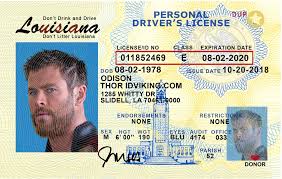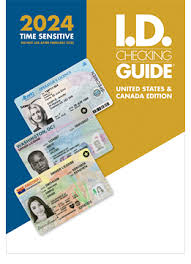How to Spot Fake IDs

Fake IDs are becoming more and more common these days. As technology has advanced, it has become easier to create high-quality fake IDs, and these forged IDs can easily be confused with real IDs. This problem is worrisome because it poses a serious threat to national security and public safety.
Fake IDs are often used by minors to purchase alcohol and cigarettes, and even to gain access to nightclubs and bars. In addition, criminals also use fake IDs to commit a variety of illegal activities. Therefore, it is essential to have a way to identify fake IDs.
Fake IDs are often used to gain access to places where the holder is not normally allowed. Bars, nightclubs, and other places that require patrons to be of a certain age are prime targets.
Often, the person entering the venue is doing so to purchase alcohol or tobacco products. It is the business's responsibility to ensure that the patron has a valid and accurate form of identification before entering. Many states have different requirements for acceptable forms of identification.
Local and state laws dictate acceptable forms of identification, but most laws have some things in common. Using a fake ID or someone else's valid identification is prohibited across the country.
In this article, we will provide a comprehensive guide on how to identify a fake ID.
Here are some common ways to spot a fake ID.
There are three basic types of ID fraud: borrowed, forged, and altered. Modernization and enhanced security features have changed the way ID fraud is committed. Borrowed IDs are the most common form of fraud, followed by forged IDs, while altered IDs are relatively rare. Here are some ways to spot problems.
Borrowed IDs – The Most Common Form of ID Fraud
Borrowed IDs are by far the most common form of ID fraud. An estimated 95% of ID fraud is caused by borrowed IDs. Minors often obtain borrowed IDs in a variety of ways: they may use an older sibling’s ID, an older friend’s ID, or a stranger’s ID through their friends and their social circles.
Here are some tips for spotting a borrowed ID:
Compare the photo on the ID to the person in front of you to check for any inconsistencies (cardholders may assume that the clerk will be too busy to check the ID).
Review and compare other physical features, such as height and weight.
Look for signs of duplicate cards, such as a “DUPL” stamp.
Check for expired cards.
Ask questions!
Ask the cardholder to verify the personal information on the card.
Get a signature and compare it to the one on the card.
Ask the cardholder what their middle initial stands for.
Intentionally mispronounce their name or misspeak their middle initial to see if the cardholder will instinctively provide the correct information.
Watch for signs of deception.
Does the cardholder avoid eye contact, show unusual hesitation in answering, act nervous, attempt to intimidate, or look upward (as if remembering or making something up)?
Counterfeit/Fake IDs
To keep up with the security upgrades of modern real IDs, counterfeit ID manufacturers use advanced technology to create fake IDs that look very "real." The Internet has become a major channel for purchasing these fake IDs. The best way to identify a fake ID is to visually and physically inspect the ID and become familiar with the style of real IDs in your community.
Fake IDs are often issued by a different state than the one where they are actually used in an attempt to fool the person checking the ID who is unfamiliar with out-of-state IDs. For example, a user might present a Texas ID to gain access to a bar in Louisiana. You can purchase an ID reference guide that contains pictures of different versions of state and foreign IDs and points out important security features to help identify fake IDs.
Perform a feel test. Real IDs are made of sturdy plastic that won't delaminate, so they won't fall apart or lose their shape. Fake IDs, on the other hand, are often made of inferior materials and delaminate. Fake IDs tend to bend or begin to peel when they are handled. Bending the edges or trying to tear the ID can improve your chances of identifying a fake ID.
Compare security features. The hologram on a real ID should flash, appear and disappear. If the hologram stays bright, regardless of how much light is reflected off the card, this could indicate a fake ID. Also, be familiar with the hologram on a Louisiana driver's license. It has four images of the state of Louisiana, and any other hologram indicates a fake document.
Inspect the front and back of the ID. Because fake ID makers often put less effort into the details on the back, the back should be examined as carefully as the front.
Swipe the magnetic stripe. If the ID is genuine, the magnetic stripe should show the cardholder's age, date of birth, and other information. Most fake IDs, even if they are high quality, will fail to recognize the ID when swiped, or will return a message that it cannot be verified.
How to spot a fake ID, including tips for identifying various fakes.
Basic ID scanners can tell if the barcode on the ID is scannable and contains encoded information. This process is called ID parsing and is an effective way to quickly identify a fake ID.
In most cases, the edges of the ID should be rounded. If the ID you receive has square edges or feels rough, it is probably a fake.
How to spot a fake military ID
Military IDs can also be faked, and many websites offer such services under the name "role playing" or "Hollywood." However, the generated IDs are quite realistic. The Department of Defense recently changed the form and appearance of IDs issued to military personnel. Here is an example:
This card has multiple verification areas, making it more obvious that it has been tampered with. Today, the penalties for using a fake military ID are very severe, so it is rare for a fake ID to be used in places such as bars. More commonly, the old green and pink military ID cards are modified for use.
How to Spot a Fake Social Security Card
The Social Security card is an important document used to identify individuals in the United States. It carries a unique Social Security Number (SSN) that is used for a variety of purposes, including applying for jobs, opening bank accounts, and obtaining government benefits. Unfortunately, like other ID documents, Social Security cards can be forged.
The first step to spotting a fake Social Security card is to understand what a real card looks like. A real Social Security card has several physical features that make it difficult to copy. These features include:
The card is made of strong, durable paper that doesn't tear or damage easily.
The text on the card is clearly readable, with no blurred or unclear letters.
The card has a unique design with a red and blue border and the words "Social Security" printed in blue font.
These physical features are difficult to replicate, so a counterfeit Social Security card may lack some or all of them.
Visual Inspection
After confirming the physical features of the Social Security card, the next step is to visually inspect it for signs of a fake card. This includes reviewing the card's text, layout, and overall appearance. During the visual inspection, there are several areas to focus on:
The name on the card matches the name of the person presenting it, which makes it more difficult to use a fake ID.
The Social Security number on the card is correct and consistent with the personal information.
The text on the card is aligned correctly, with no overlapping letters or numbers.
UV Light Inspection
Similar to real ID cards, many real Social Security cards have features that can only be seen under ultraviolet light. Therefore, performing a UV inspection is another way to identify counterfeit Social Security cards, which is essential for identity verification. When performing a UV inspection, there are several areas to focus on:
Counterfeit IDs
Modern IDs are much more difficult to alter than in the past. For example, with advances in ID printing technology and the use of specialized plastic materials, it has become very difficult to alter an ID photo, which is almost uncommon on new IDs. The current trend in ID alterations is to change the date of birth, the "Under 18 Until" or "Under 21 Until" dates.
The most common way to alter an ID is to use clear nail polish or super glue and then write or print new dates on these materials. So, to identify an altered ID, you can look for the following:
Check for small raised dots or small shiny spots on the date of birth or "Valid Until" date, as these can be signs of a counterfeit ID.
Check for changes in font or color.
Different font types on the card
Colors that blur or bleed through the card.
Raised dots or raised stripes on the card
Ways to confirm an ID
– Check the date of birth, expiration date, and photo.
If it is an out-of-state driver's license, check the "ID Check Guide" for the specific style for that state.
If the ID is a duplicate, provide a second ID.
– Check eye and hair color, weight, and height.
- Check the restrictions on the license. For example: "underage".
Check the ID itself for physical alterations or signs of possible tampering (such as glue marks, etc.).
Uneven surfaces, coverings, etc.
If the person wears items or jewelry with initials, check those initials against...
D.
Be aware of other people the person is communicating with. They may accidentally address the wrong person.
The person's name is different from the name on the ID.
– Ask the person questions about their personal identification information. – They should be able to
respond without hesitation if it is their real information.
- Learn and memorize their zodiac signs. This is a very clever way to...
Reveal a fake ID. Almost everyone knows their zodiac sign, even if they don't necessarily understand it.
Believe in astrology.
Physically inspect the ID.
Check the hardness of the ID. Fake IDs often differ from the real thing in weight and/or thickness. Gently pinch the ID to determine if the ID feels normal.
Check the edges of the ID. Almost all IDs have rounded corners. If the edges feel square, then it is probably a fake ID.
Check and feel the front and back of the ID. Feel for bumps, ridges, and irregularities.
Check the ID’s corners. The corners of the ID cannot be split or torn. If you can tear or split the corner of the ID with your fingernail, it is most likely a counterfeit ID.
Perform a thorough visual inspection of the overall appearance, fonts, and color patterns, while noting known security features that should be on valid documents.
Don’t forget to check the back of the ID. People who create fake IDs often copy the front of the ID very carefully, but pay less attention to detail on the back.
How to Spot Fake IDs in Each State
Train your employees to spot fake IDs by familiarizing yourself with the security features of your state’s IDs. Here are some things to look for:
Holograms
IDs have holographic images that show up when you hold them up to a light. Each state has a unique image, and knowing your ID pattern will help you spot a fake ID.
Cheap Laminates
States apply professional-grade lamination to their IDs to seal out their UV image and protect the ID. To tell if the ID in front of you has professional-grade lamination, gently bend the ID into a “U” shape. Cheap, non-professional laminators can have bubbles if the lamination is poor quality.
Laser Perforations
The ID card has tiny laser-punched holes that create a pattern that is invisible to the naked eye and can only be seen if you hold a light to it. The pattern of these laser-punched holes varies from state to state.
Laser Embossing
Many states use a laser to engrave a raised pattern on the front of the ID card. Laser engraving does not affect the back of the ID card, but allows a person to touch the card and check that the embossing is present and meets standards.
UV image
ID card UV images vary from state to state, but most states include a second, lighter image that only appears when exposed to UV light.
Over the past decade, U.S. states and Canadian provinces have made significant security upgrades to driver's licenses and identification cards. Some of these enhanced security features require special equipment (such as a UV light source or a magnifying glass) to be viewed, while others can be identified by eye, touch, or simply by tilting the card or looking at it against a light source.
The infographic at the bottom of this page shows some of the easily verifiable features of these driver's licenses and ID cards.
There is no uniform standard regarding the security features used on ID documents and their location.
Under federal law, the Social Security number (SSN) is no longer used as a driver's license number. However, some states may still have a small number of older driver's license documents that contain the SSN, as shown below. The table below shows the format of driver's license numbers by state.
 Fake Permanent Resident Card
Fake Permanent Resident Card
 Fake US Permanent Resident
Fake US Permanent Resident
 Fake US Green Card
Fake US Green Card
 Replace Social Security Card
Replace Social Security Card